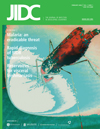Hantavirus Infection: a review and global update
DOI:
https://doi.org/10.3855/jidc.317Keywords:
hantavirus, hemorrhagic fever with renal syndrome, HFRS, hantavirus pulmonary syndrome, HPS, rodent control, vaccineAbstract
Hantaviruses have the potential to cause two different types of diseases in human: hemorrhagic fever with renal syndrome (HFRS) and hantavirus pulmonary syndrome (HPS). HFRS, initially described clinically at the turn of the 20th century, occurs endemically in the Asian and European continents, while HPS, recognized as a clinical entity since 1993, represents the prototype of emerging diseases occurring in the Western hemisphere. Approximately 150,000 to 200,000 cases of HFRS are hospitalized each year world wide, with most of the cases occurring in the developing countries. The case fatality rate of HFRS varies from <1% to 12% depending on the viruses. Although HPS is much smaller in number than HFRS, with approximately 200 HPS cases per year in the Americas, the average case fatality rate is 40%. The reported cases of hantaviral infection is increasing in many countries and new hantavirus strains have been increasingly identified worldwide, which constitutes a public health problem of increasing global concern. Hantaviral infection might be underestimated due to its asymptomatic and non-specific mild infection, and the lack of simple standardized laboratory diagnostics in hospitals, especially in the developing countries. This review summarizes the current knowledge on virology, epidemiology, clinical manifestation, laboratory diagnostics, treatment and prevention of hantaviruses and hantaviral infections.Downloads
Published
2008-02-01
How to Cite
1.
Bi Z, Formenty PB, Roth CE (2008) Hantavirus Infection: a review and global update. J Infect Dev Ctries 2:003–023. doi: 10.3855/jidc.317
Issue
Section
Reviews
License
Authors who publish with this journal agree to the following terms:
- Authors retain copyright and grant the journal right of first publication with the work simultaneously licensed under a Creative Commons Attribution License that allows others to share the work with an acknowledgement of the work's authorship and initial publication in this journal.
- Authors are able to enter into separate, additional contractual arrangements for the non-exclusive distribution of the journal's published version of the work (e.g., post it to an institutional repository or publish it in a book), with an acknowledgement of its initial publication in this journal.
- Authors are permitted and encouraged to post their work online (e.g., in institutional repositories or on their website) prior to and during the submission process, as it can lead to productive exchanges, as well as earlier and greater citation of published work (See The Effect of Open Access).








